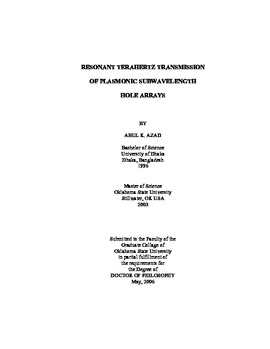| dc.contributor.advisor | Zhang, Weili | |
| dc.contributor.author | Azad, Abul K. | |
| dc.date.accessioned | 2013-12-10T18:05:44Z | |
| dc.date.available | 2013-12-10T18:05:44Z | |
| dc.date.issued | 2006-05 | |
| dc.identifier.uri | https://hdl.handle.net/11244/7844 | |
| dc.description.abstract | Scope and Method of Study: The purpose of this study was to examine the extraordinary terahertz (THz) transmission through subwavelength hole arrays structured on metals, highly doped and photo-doped silicon. Conventional photolithography process was used to structure subwavelength hole arrays on good and poor metallic conductors as well as on thin, doped silicon wafers. The transmission properties of the THz radiation through these hole arrays were investigated using terahertz time-domain spectroscopy (THz-TDS) and optical pump-THz probe techniques. | |
| dc.description.abstract | Findings and Conclusions: The frequency-dependent transmission spectra through hole arrays show extraordinary transmission at resonance peaks. This phenomenon is attributed to the resonance excitation of surface plasmon polaritos (SPPs) which might find applications in THz photonic devices. The incident THz radiation excites SPPs on the incidence surface of the array; the SPPs then tunnel through the subwavelength holes and reradiate as THz radiation from the other surface. This study demonstrated the effect of hole shape, dielectric properties of the metallic and surrounding media, polarization dependence, and the metal thickness on the enhanced THz transmission. Rectangular and elliptical hole shapes show higher peak transmission when the polarization of incident THz beam is perpendicular to the longer axis of the holes. Amplitude of the peak resonance decreases and shifts toward the lower frequencies when the dielectric constant of the surrounding medium increases. Efficiently enhanced transmission has been realized with the metallic arrays having thickness of one-third of the skin depth. For similar array, transmission is higher for the array made from metals having higher electrical conductivity. Furthermore, the transmission properties of a lightly doped silicon hole array can be dynamically tuned from two-dimensional photonic crystal features to SPPs resonance with increased photo-doping density by varying external optical excitation power. | |
| dc.format | application/pdf | |
| dc.language | en_US | |
| dc.rights | Copyright is held by the author who has granted the Oklahoma State University Library the non-exclusive right to share this material in its institutional repository. Contact Digital Library Services at lib-dls@okstate.edu or 405-744-9161 for the permission policy on the use, reproduction or distribution of this material. | |
| dc.title | Resonant terahertz transmission of plasmonic subwavelength hole arrays | |
| dc.contributor.committeeMember | Cheville, Alan | |
| dc.contributor.committeeMember | Grischkowsky, Daniel | |
| dc.contributor.committeeMember | Xie, Xincheng | |
| osu.filename | Azad_okstate_0664D_1764.pdf | |
| osu.accesstype | Open Access | |
| dc.type.genre | Dissertation | |
| dc.type.material | Text | |
| thesis.degree.discipline | Electrical and Computer Engineering | |
| thesis.degree.grantor | Oklahoma State University | |
